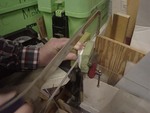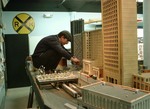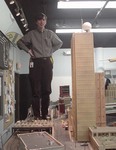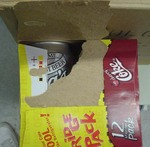- March 1
 Andy showed up and painted some cars, including some N-scale equipment. John Shriver had some pizza, relocated one trolley pole in front of the passenger station, and installed more of the trolley wire hangers. As seen in the picture John McNamara did a heroic job of slicing a piece of molded-plaster rock wall the hard way. The piece is about 3 inches square and was about an inch thick before he sliced it in two. This helps the piece fit better near the tunnel portal he has been working on recently. Despite the fact that he was photographed during the cutting process (resulting in a massive release of psitons) he was successful in this challenging task. Fortunately, he offset his fine work in this area by immediately proceeding to stain the surface of the piece the wrong color, saving us from having to alter psiton theory.
Andy showed up and painted some cars, including some N-scale equipment. John Shriver had some pizza, relocated one trolley pole in front of the passenger station, and installed more of the trolley wire hangers. As seen in the picture John McNamara did a heroic job of slicing a piece of molded-plaster rock wall the hard way. The piece is about 3 inches square and was about an inch thick before he sliced it in two. This helps the piece fit better near the tunnel portal he has been working on recently. Despite the fact that he was photographed during the cutting process (resulting in a massive release of psitons) he was successful in this challenging task. Fortunately, he offset his fine work in this area by immediately proceeding to stain the surface of the piece the wrong color, saving us from having to alter psiton theory.
- March 4
John Shriver made a rare Saturday visit to the club and hung more trolley wire. Jeff Birkner , who hasn't come to the club in quite a while, has been cleaning out his garage and came to the club to drop off some stuff he found. Alvar was called in to make sure the stuff Jeff was leaving off was potentially useful to the club.
A date was scheduled for the spring open house (6 May), and Andy discussed the possibility of arranging a tour of the T or an Amtrak facility in the fall.
- March 8

 John Shriver continued to hang trolley wire. He has now reached an area that is basically inaccessible from the floor, so he decided to stand on the layout. Fortunately, he resisted the urge to have a Godzilla moment. Johns Purbrick and McNamara sorted through some of the stuff Jeff Birkner brought in Saturday night. James and Genya worked on the programming for the turntable.
John Shriver continued to hang trolley wire. He has now reached an area that is basically inaccessible from the floor, so he decided to stand on the layout. Fortunately, he resisted the urge to have a Godzilla moment. Johns Purbrick and McNamara sorted through some of the stuff Jeff Birkner brought in Saturday night. James and Genya worked on the programming for the turntable.
 While filling the soda machine, Tom discovered an anomalous can of Barq's Root Beer in an unopened case of Cherry Coke. Which is rather weird.
While filling the soda machine, Tom discovered an anomalous can of Barq's Root Beer in an unopened case of Cherry Coke. Which is rather weird.
- March 22

The turntable is in measurable distance of being returned to useful life, now with a PIC microcontroller replacing the 1990-vintage 8031. It now has the ability to interact with the System (blue cables) and fits on one circuit board rather than two. Hardware by John Purbrick, software by Genya Zaytman. The five flat objects form a relay tree which powers one approach track. The Maxim circuit board is a step-up voltage converter which produces 24 volts for the relays; we don't have a power supply for this voltage. The microcontroller itself is in the lower left, with a white label.

In case anyone's forgotten, the turntable looks like this. The boxcar is in use to test alignment of the rail ends.
|
|
